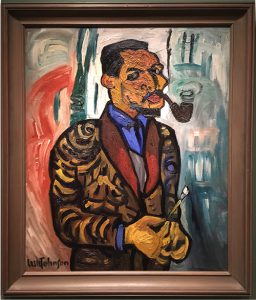
Close-up of Penchick by South Carolina artist Melvin Way.
By Andy Brack, editor and publisher | The creativity, inventiveness and talent of people who grow up and live in the South, and particularly South Carolina, never ceases to amaze.
A week ago during a visit to Washington, D.C., we stumbled upon the Smithsonian American Art Museum (SAAM), also home to the National Portrait Gallery. We were familiar with all sorts of other Smithsonian museums, but had never heard of this one, located a few blocks north of the National Mall.
In the short time we had at the museum, we found art from three different South Carolinians.

Self-Portrait with Pipe, about 1937, oil on canvas; William H. Johnson (born in Florence S.C. in 1901 – died in Central Islip, N.Y., 1970)
In a special exhibition called “Experience America,” the museum offered a look at American art during the 1930s, with works by Edward Hopper or others who became familiar as artists in New Deal programs. One of the artists represented was William H. Johnson, a modern painter born in Florence in 1901 who left the Pee Dee at age 17 for New York’s art world.
Back in 2013, we discovered Johnson’s work at a special exhibition at the Jones-Carter Gallery in Lake City, where we were blown away as outlined here. While living in New York, he saved money to pay for classes at the National Academy of Design. He enjoyed some success with his modern paintings with folk influences, but by middle age, he wasn’t able to sustain himself through art. He reportedly stopped painting in 1956 and lived in a state hospital for the last 23 years of his life.
Johnson’s art — more than 1,000 pieces — almost was thrown away, but was rescued by friends and later given to the Smithsonian American Art Museum. In 2012, the U.S. Postal Service honored Johnson’s talent by issuing a postage stamp in recognition of being one of the country’s most important African-American artists.
Last week in Washington, the SAAM featured a self-portrait of Johnson near masterpieces by Hopper and others.

Penchick, ballpoint pen and ink on paper with tape; Melvin Way, born in Ruffin S.C. in 1954
Just a few feet away in a section of the museum on “Folk and Self-Taught Art,” we encountered the hieroglyphic, formulaic pen-and-ink drawings of Melvin “Milky” Way, born in 1955 in Ruffin in Colleton County, S.C. We hadn’t heard of Way, but like Johnson, he eventually moved to New York City. In 2016, he received a Wynn Newhouse Award worth $60,000. Read his unedited artist statement.
According to SAAM, “Melvin Way’s cryptic diagrammatic drawings look like calculations in some unknown system. They draw on various bodies of knowledge – biology, chemistry, math, physics, linguistics — but only Way grasps their exact meaning. Way was adept at science and mechanics before the onset of schizophrenia when he was in his early twenties set him on a different course. His small, highly personal, unsolvable cryptograms travel with him, sometimes for days, weeks, even years, being worked and re-worked, added to, torn, taped up. They become not only intense communiques, but physical records of both his understanding of the world and his travels through it.”
We were about to leave the museum for a lunch appointment when we noticed a special exhibition of war photographs taken since 2001. A full room of stunning photos were the work of Air Force combat photographer Stacy Pearsall, former owner of the Charleston Center for Photography.

Brotherhood, aluminum photographic prints, Stacy Pearsall, born in 1980
A photo that captivated us was of U.S. Army Staff Sgt. Branden Embry embracing a fellow soldier after a combat operation in Iraq in February 2007, a tough month during which his team lost five soldiers.
From the artist’s statement at the museum: “I sought to capture combat’s physical and emotional toll, illustrate the intimate bonds forged under fire, and demonstrate the personal solitude felt by many despite being surrounded by people. There is more to war than bullets – there are human beings.”
MOVING TO POLICY: You can read our most recent Statehouse Report commentary by clicking here. An excerpt:
“If you think Obamacare is a disaster, get ready for whatever it is that the Congressional Republicans passed to fix the Affordable Care Act as the political cluster that could be the mother of all nightmares. Why? Because instead of making something that’s a policy and political mess less messy, it’s going to be even messier, particularly after the U.S. Senate gets it.”



 We Can Do Better, South Carolina!
We Can Do Better, South Carolina!
























